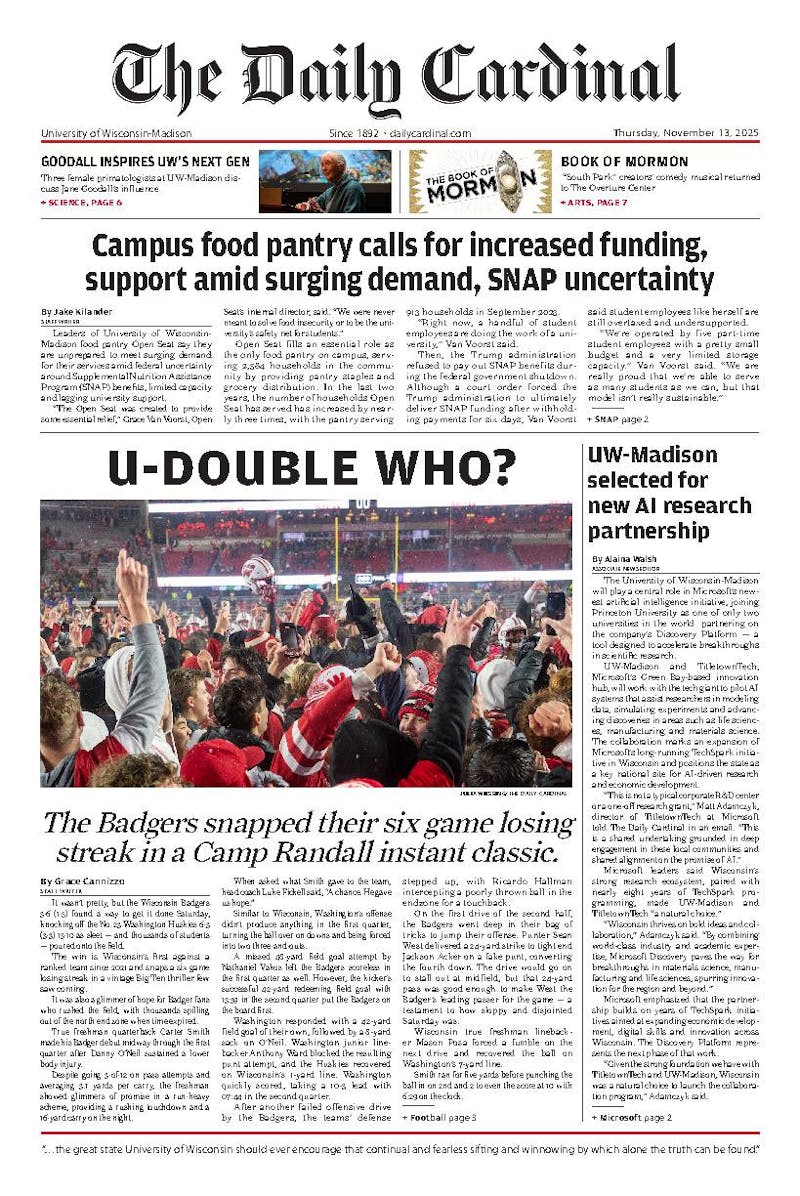‘Tis the season—the leaves have changed, mittens and scarves have been pulled from the closet, and the sound of jingling bells is right around the corner.
But for many students, the winter season means long nights at the library and battles with the common cold. In order to stay healthy and in tip-top shape this winter season, students should take preventive measures early on.
One of the most important variables in maintaining good health is an individual's diet and nutrient intake. Nutritionists recommend students to make a conscious effort in maintaining good health this winter by incorporating into their diets a variety of foods that are especially nutrient dense.
Most nutritionists and health professionals, including those here at the UW-Madison's University Health Services and nutritional science department, encourage a balanced diet that includes fruits, vegetables, whole grains, low-fat dairy, meat or other healthy proteins without exceeding caloric needs.
That being said, there are a few select foods that can be considered ""super"" for their high nutrient density and specific health benefits. Adding super foods to your daily diet is a great way to help boost your immune system and enjoy the splendors of the holiday season sickness-free.
Many of these super foods—such as salmon, turkey, walnuts, soy and beans—are good sources of protein. Protein is essential in a diet because it contains amino acids that are required for many metabolic reactions such as immune responses and muscle growth for increased strength. According to Dr. Susan Nitzke, a UW-Madison nutritional science professor, beans are a particularly good source of protein because they area low-fat alternative to meat for protein intake.
Nitzke also said dry beans and peas are good sources of nutrients such as folate, iron, zinc and fiber. Therefore, she recommended consuming several cups per week.
Beans and other legumes are not the only way to incorporate important vitamins and minerals in a diet. Broccoli, oranges and spinach, Nitzke added, are also rich in folate, which is important in new cell growth and red blood cell reproduction. Yogurt and other low-fat dairy products are essential for calcium intake and aid in both bone formation and muscle contractions.
According to Dr. Mary Landry of UHS, tomatoes, oranges, red peppers and blueberries are good sources of Vitamin C and other antioxidants that are key in disease prevention. Nitzke added that blueberries and other berries are full of vitamins, minerals and dietary fiber, making them extremely nutrient dense foods.""Most berries are also good sources of phytonutrients such as anthocyanins and phenolics, which are believed to fight diseases and promote good health,"" she said.
Coming to the end of the list of super foods are oats and pumpkin, both of which are examples of are foods that are high in dietary fiber.
One of the biggest challenges students face while trying to eat balanced and healthy diets is figuring out how to incorporate these foods into their daily routines.
Dr. David Eide of the UW-Madison nutritional sciences department advises students to ""eat their way to better health"" by eating a balanced diet. Eide emphasized that no one food is a cure-all for sickness.
""None of [the foods] are ‘super'—they are all just good sources of various nutrients without the bad stuff processed foods often contain,"" he said.
Eide cautioned against eating too many processed foods.
""Commercially prepared foods often have high levels of sugar, salt, and fat content,"" he said. ""I know it is hard to find time to cook but a good trick is to make extra whenever you do and freeze portions away for later.""
Some quick and easy ways to incorporate these super foods into a hectic schedules are by making and eating bean chili, stir-fries (try one with tofu for a new protein), soups with vegetables and beans, veggie burgers, hummus (made with chickpeas—a good source of protein), fruit smoothies made with low-fat dairy and whole grain breads or cereals.
It is important to explore a variety of healthy foods to find favorite tastes and incorporate them in a nutritious diet. Landry sticks by this simple philosophy and advises students to do the same.
""Eat a varied diet of healthy foods that you like because the list of super foods is ever-changing,"" she said. ""Don't make yourself eat broccoli if you don't like broccoli—eat tomatoes instead.""
Trying new healthy foods and recipes (such as the few below) can be easy and fun with websites such as http://www.yumyum.com/student/ that focus on cooking for college students. With a little effort, adding healthy options like the super foods to your diet can super-charge the body for both those inescapable nights at the library and all those cold walks to parties and bars this winter.
Recipes:
Chili Recipe (http://www.yumyum.com/student/)
A½ c chopped onion
A¼ tsp ground black pepper
2 A½ tsp chili powder
1 A½ tsp salt
1 lb can drained kidney beans
1 lb can stewed tomatoes
1 lb can tomato sauce
1 lb lean ground beef
1/4c chopped green pepper
A½ tsp dry mustard
Instructions:
Place plastic colander in a 2-quart microwave-safe casserole.
Combine onion, green pepper, and crumbled ground beef in colander.
Microwave (high or 100% power) for 6 minutes, stirring once halfway through cooking.
Remove colander and pour off drippings.
Turn meat mixture into casserole.
Add tomato sauce, tomatoes, beans, salt, chili powder, black pepper, and mustard.
Cover.
Microwave (high or 100% power) for 10-12 minutes, stirring halfway through cooking.
Rest, covered, for 5 minutes.
Blueberry Smoothie (http://www.low-fat-recipes.com)
A¼ c blueberries, frozen
1 banana
8 oz vanilla yogurt, fat free
2 tbsp pineapple-orange juice
6-10 ice cubes
Instructions:
Place all ingredients in blender, and blend.





